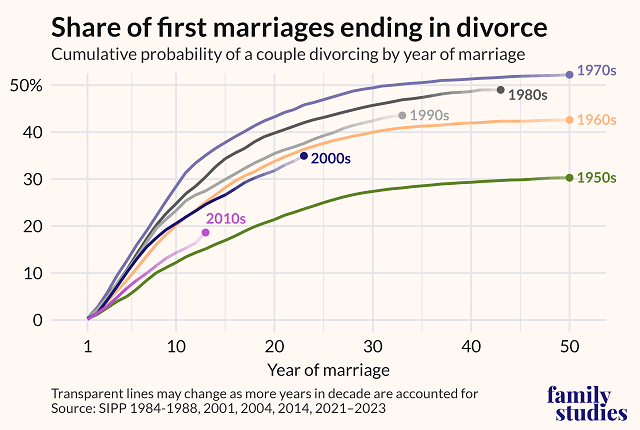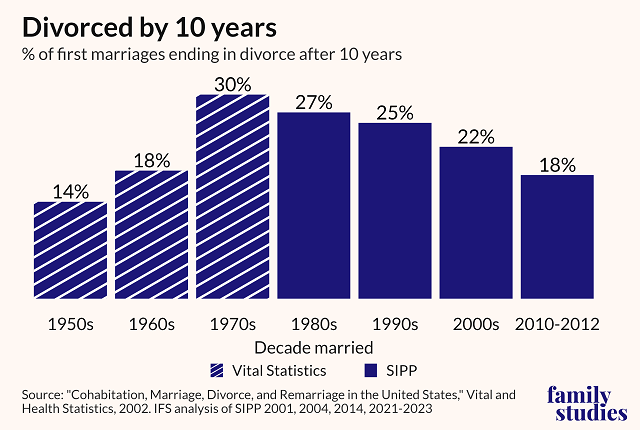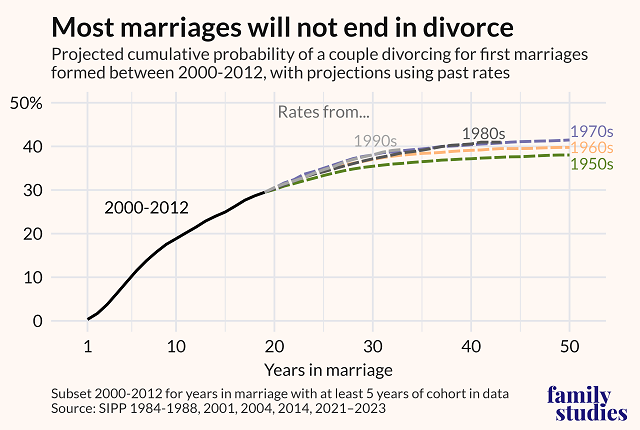Highlights
- Using the Survey of Income and Program Participation (SIPP), we found that new marriages are stronger today than in every decade since the 1950s. Post This
- Using the SIPP, we estimate that just 15% of marriages formed between 2010 and 2012 were divorced after 10 years. Post This
- If later-year divorce rates look more like the 1960s, then we should see about 40% of these marriages end in divorce. But if marriages trend toward further stability, then we see under 40% of first marriages ending in divorce. Post This
We’ve all heard the mantra that half of all marriages end in divorce. This idea often gets peddled as a way of dissuading young adults from tying the knot. If you only have 50/50 odds of making it, is marriage really worth the risk?
Much of this caution surrounding marriage comes from those who’ve personally witnessed broken vows or experienced the fallout that results. Prior to the divorce revolution, less than a third of marriages ended in divorce. But the cultural transformation of the 1960s and 1970s radically changed the stability of American unions. It’s from such marriages, formed during the heyday of hippies through the MTV era, that we get the idea that 50% of marriages end in divorce. And it’s this picture of marriage that has been pressed into the American understanding of the fate of newlyweds.

Figure 1. Share of first marriages ending in divorce. Source: SIPP 1984-1988, 2001, 2004, 2021-2023
But the fortunes of marriage have changed in recent years. Marital stability looks much different than it did 30 years ago. Using the Survey of Income and Program Participation (SIPP), we found that new marriages are stronger today than every decade since the 1950s. While new marriages in the 2000s initially resembled those from the 1990s, divorce rates slowed down after 5 years into marriage. By 20 years in, marriages in the 2000s were performing similarly to those from the 1960s.

Figure 2. Percent of first marriages ending in divorce after 10 years. Source: Vital and Health Statistics, 2002. IFS Analysis of SIPP 2001, 2004, 2014, 2021-2023
We’ve been witnessing an increase in marital stability since the end of the 1970s. And so far, marriages formed in the 2010s are sticking to this trend. Using the SIPP, we estimate that just 18% of marriages formed between 2010 and 2012 were divorced after 10 years. We found slightly lower 10-year survival rates for marriages from the 2010s using the American Community Survey, with about 19% divorcing. Compare this to 30% of marriages dissolving after 10 years from the 1970s. While not quite at 1950s levels (which saw only 14% of marriages dissolve after 10 years), the future of this new cohort looks much more stable.
That is, in part, because marriages formed between 2010 and 2012 have already put the hardest years behind them. Among 21st century new marriages, peak marital instability happens early on and earlier than those formed in the latter half of the 20th century. For instance, marriages formed in the 1970s saw peak marital instability around 8 to 10 years in. But for marriages made in the 2000s, divorce risk peaked around 5 years. Yearly risk of divorce has trended downward since.
But what of “gray divorce”—where couples divorce when they are 50 or older? Demographers have found that despite divorce rates falling overall, older married adults have less stable marriages than in years past. Are couples simply delaying divorce until the silver years?
It’s hard to say whether 21st century marriages will see a long tail of marriage breakup. When “gray divorce” is analyzed today, it is those marriages formed during the turbulent years of the divorce revolution often being observed. Consider that over half of married adults over the age of 60 wedded in the 1970s and 1980s. When we look at heightened divorce rates among older Americans, we are seeing, in part, the long tail of the 20th-century upheaval. The stability of new marriages suggests this revolution is over.
If marriages trend toward further stability, as we see with those from 2010–2012, then we could even see under 40% of first marriages ending in divorce.
So, what does the future hold for 21st century marriages? Prediction is no easy task. One common method employed to forecast marriage stability works by freezing current divorce rates at their present level and projecting out. In other words, we look at the divorce rates of the current year for couples married one year, two years, three years, etc., and use these rates to form an artificial marriage path. This is the method sociologist Yifeng Wan used to find that just 42% of new marriages will end in divorce. This strategy is a good one, and simply assumes divorce rates will stay unchanged.
But while such an assumption is useful, it is very likely not correct. As noted earlier, the later-year divorce rates come from marriages predominantly formed in the 1970s and 1980s. Newer marriages have already shown higher stability, and this may be because newer marriages are more selective. In the 1980s, 80% of adults married by the age of 30. Between 2000 and 2012, just 64% of adults had married by then. The composition of the married population has changed.
This isn’t to say we can’t use older generations to project into the future. Indeed, that’s all we can really do. But it is to say that marriage cohorts matter, and past stability may indicate future stability. We can get an additional look at where marriage is going by looking at where it’s been—by using past marriage cohorts to give us a range of possible futures.

Figure 3. Projected cumulative probablity of a couple divorcing for first marriages formed between 2000-2012, with projections using past rates. Source: SIPP 1984-1988, 2001, 2004, 2014, 2021-2023
Using past divorce rates, we see a range of possibilities for the future of 21st century marriages. If heightened “gray divorce” persists, as we see for marriages from the 1970s to 1990s, then over 40% of first marriages formed between 2000 and 2012 will end in divorce. Indeed, this scenario aligns with the 42% cumulative divorce rate projected by Yifeng Wan. If later-year divorce rates look more like the 1960s, then we should see about 40% of these marriages end in divorce. But if marriages trend toward further stability, as we see with those from 2010–2012, then we could even see under 40% of first marriages ending in divorce.
Right now, our best estimate is that about 40% of today’s first marriages will end in divorce. But only time will tell.
Grant Bailey is Research Associate at the Institute for Family Studies. Lyman Stone is Senior Fellow and Director of the Pronatalism Initiative at the Institute for Family Studies. Brad Wilcox is Distinguished University Professor of Sociology at the University of Virginia, Senior Fellow at the Institute for Family Studies, and nonresident Senior Fellow at the American Enterprise Institute.
Editor's Note: An earlier version of this article reported that an estimated 15% of marriages formed between 2010 and 2012 ended in divorce. This has been corrected to 18 percent.
*Photo credit: Shutterstock










